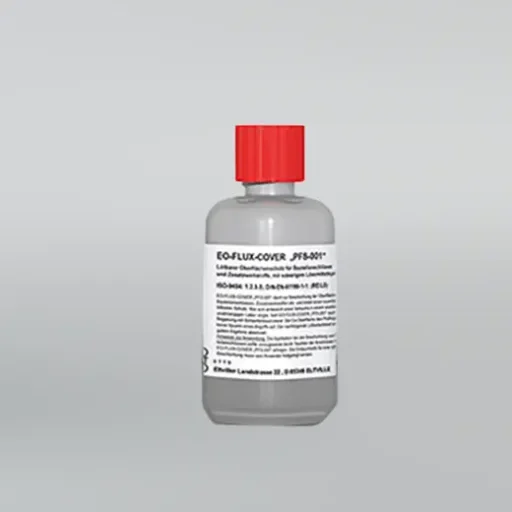Solderable surface protection for component connections and additional materials
With aqueous solvent system
Type ISO-9454: 1.2.3.B // DIN-EN-61190-1-1: (ORL0)

| Appearance: | milky, homogenous liquid |
| Density 20 °C: | 1,1 g/cm³ |
| FFlash point: | non flammable |
| Substances: | water-based |
| Activators: | complex with carboxylic and di–carboylic acids |
EO FLUX-COVER PFS-001 is used for coating the surfaces of component connections, additional materials, etc. and provides reliable, solderable protection. As a result of an experiment in a recognized, independent laboratory, EO FLUX-COVER PFS-001 also stood up to gassing with sulfur dioxide (SO2). The Cu surface of the sample did not show any traces of attack. The subsequent solderability test was completed with good results.
Notes on application: The application for the coating of component connections should preferably be done by dipping the connections in EO FLUX-COVER PFS-001. The immersion depth for an optimum coating must be defined by the user.
Immediate processing of coated components: If the components are fitted immediately after the coating process, they can be processed directly in “hand-held” (in the case of automatic assembly, subsequent drying is required). The following wave soldering process can be carried out as usual, that is, the selected parameters generally need not be changed.
Storage of coated components: If the coated parts are not to be processed immediately but stored, the coatings must be dried immediately and completely before storage. This is the only way to prevent sticking. Depending on the applied amount of the surface protection, a drying “15 minutes at 120 ° C” is sufficient according to experience. Subsequent storage can be carried out at room temperature. Coated components removed from the bearing can generally be equipped without further pretreatment.
The viscosity of EO FLUX-COVER PFS-001 can be adjusted by the user by adding EO SPECIAL THINNER PFS-V / WB, cat.-no. 1008 can be adjusted.
When the medium is used, it evaporates, slowly but constantly, constituents of the solvents. In order to return the product to the delivery state, the acid number must first be determined by means of titration. Via the determined value, the required pulling quantity of the special thinner can be determined by means of a corresponding dilution table. This document is available upon request.